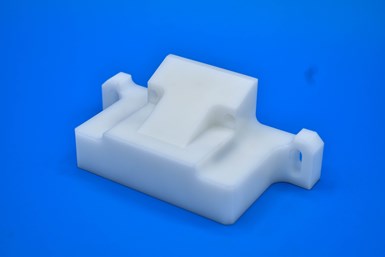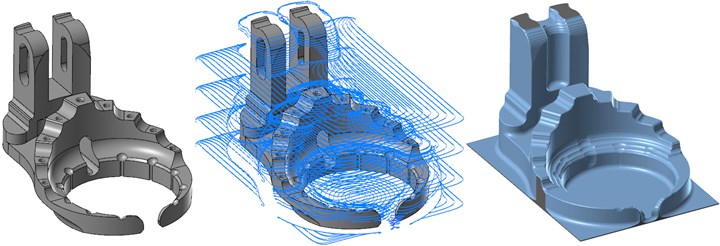In Plastics Machining, One Sharp Tool Does It All
Milling plastic can pose a variety of challenges, but keep a few principles in mind and quality parts will follow.
Share




With a business model sketched out on a napkin at the start of 2017, Greg and Shelly McArthur dedicated their home garage to a new business venture: a CNC machine shop. NTL Industries Inc. would be Greg’s opportunity to take everything he had learned in his 20 years of CNC machining experience and make a go at running his own business from the ground up.
After a year in the garage shop, the shop had the opportunity to upgrade to a larger space in Sterling Heights, Michigan. The move to the new facility was built on a culture of saying “yes” to as many RFQs as possible.
In some cases, saying “yes” involves working with whatever material the customer specifies, even if it falls outside the norm. One recent example was a small plastic part for the automotive industry. The size and shape of the part didn’t immediately lend itself to a fast cycle time, but McArthur was confident that he could make it a profitable part.

NTL Industries Inc. serves a wide range of industries but is pushing its product development into the motorsport industry. With each new job, the shop is quick to equip itself with machines and tooling that keep it ahead of the competition.Photo Credit: Jeannie Skirpan, NTL Industries Inc.
Plastic machining requires thinking differently than machining other materials, but McArthur has a simple approach: “I treat it like aluminum, but faster.” Asked for more specifics, he cites the following principles as key to plastic milling success:
-
Avoid the Melting Point
McArthur’s “faster” motto mitigates the thermal issues that often plague plastic operations. This is because plastic — in this case, ultra high molecular weight (UHMW) polyethylene — often has significant problems during milling operations. The melting point is around 260°F, and thermal expansion happens rapidly. If the feed rate were too slow, the material could build up around the cutting edge and start to melt back together. These blobs and hanging bits of melted plastic interfere with the cut and lead to even greater heat buildup, compounding the problem. Running without coolant also promotes faster chip evacuation with the plastic material.

The right tool path enabled milling the entire part with a single end mill in three setups and 37 minutes on a 3-axis mill.
Photo Credit: Jeannie Skirpan, NTL Industries Inc.
-
Sharp Tools Are Imperative
When cutting any kind of plastic, a brand-new tool is best. This ensures that the material will not absorb any additional friction as result of a dull cutting edge.
McArthur used a 0.25", 3-flute carbide end mill with a 0.030" corner radius for all operations on this part, from roughing to finishing. The rounded end of the bit enabled chamfering operations without changing the tool. A final cycle time of 37 minutes made this a profitable part for the shop.
- CAM From the Bottom up
McArthur also cites Mastercam’s Optirough tool paths as critical to making this plastic part a profitable part. This strategy improved cutting efficiency by engaging a larger portion of the end mill’s length, thereby avoiding concentrating wear at the tool tip.
The plastic part was a good candidate for Optirough in part because it has features and faces at different heights, McArthur says. Such geometry facilitates aggressive roughing between the features using as much of the tool flute as possible. For this job, McArthur was able to maintain a 1.125" depth of cut with a 10% step over. Reducing passes is a common way that NTL Industries seeks to make their processes more efficient, “How can I create this part with the smallest number of passes to get the shape I need?” McArthur asks.

OptiRough is well suited for tall parts with significant horizontal steps. Deep, optimized cuts with a consistent chip load save machining time and reduce tool wear. Solid verification of the process not only lets the user check the results, but provides a solid model reference for the finish tool paths to work from.
Photo Credit: Mastercam
Related Content
Automated CAM Programming – Is Your Software Really Delivering?
A look at the latest automation tools in Autodesk Fusion 360 software and how forward-thinking machine shops and manufacturing departments are using them to slash delivery times and win more business.
Read More4 Commonly Misapplied CNC Features
Misapplication of these important CNC features will result in wasted time, wasted or duplicated effort and/or wasted material.
Read MoreERP Provides Smooth Pathway to Data Security
With the CMMC data security standards looming, machine shops serving the defense industry can turn to ERP to keep business moving.
Read MoreContinuous Improvement and New Functionality Are the Name of the Game
Mastercam 2025 incorporates big advancements and small — all based on customer feedback and the company’s commitment to keeping its signature product best in class.
Read MoreRead Next
Registration Now Open for the Precision Machining Technology Show (PMTS) 2025
The precision machining industry’s premier event returns to Cleveland, OH, April 1-3.
Read More5 Rules of Thumb for Buying CNC Machine Tools
Use these tips to carefully plan your machine tool purchases and to avoid regretting your decision later.
Read MoreSetting Up the Building Blocks for a Digital Factory
Woodward Inc. spent over a year developing an API to connect machines to its digital factory. Caron Engineering’s MiConnect has cut most of this process while also granting the shop greater access to machine information.
Read More






























